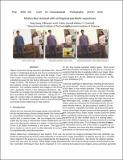| dc.contributor.author | Cho, Taeg Sang | |
| dc.contributor.author | Levin, Anat | |
| dc.contributor.author | Durand, Fredo | |
| dc.contributor.author | Freeman, William T. | |
| dc.date.accessioned | 2011-05-11T20:21:40Z | |
| dc.date.available | 2011-05-11T20:21:40Z | |
| dc.date.issued | 2010-03 | |
| dc.identifier.isbn | 978-1-4244-7022-8 | |
| dc.identifier.other | INSPEC Accession Number: 11553745 | |
| dc.identifier.uri | http://hdl.handle.net/1721.1/62818 | |
| dc.description.abstract | Object movement during exposure generates blur. Removing blur is challenging because one has to estimate the motion blur, which can spatially vary over the image. Even if the motion is successfully identified, blur removal can be unstable because the blur kernel attenuates high frequency image contents. We address the problem of removing blur from objects moving at constant velocities in arbitrary 2D directions. Our solution captures two images of the scene with a parabolic motion in two orthogonal directions. We show that our strategy near-optimally preserves image content, and allows for stable blur inversion. Taking two images of a scene helps us estimate spatially varying object motions. We present a prototype camera and demonstrate successful motion deblurring on real motions. | en_US |
| dc.description.sponsorship | United States. National Geospatial-Intelligence Agency ( NGA NEGI-1582-04- 0004) | en_US |
| dc.description.sponsorship | United States. Office of Naval Research. Multidisciplinary University Research Initiative (Grant N00014-06-1-0734) | en_US |
| dc.description.sponsorship | Microsoft Corporation | en_US |
| dc.description.sponsorship | Google (Firm) | en_US |
| dc.description.sponsorship | Adobe Systems | en_US |
| dc.description.sponsorship | Quanta Computer (Firm) | en_US |
| dc.description.sponsorship | T-Party Project | en_US |
| dc.description.sponsorship | Samsung Scholarship Foundation | en_US |
| dc.language.iso | en_US | |
| dc.publisher | Institute of Electrical and Electronics Engineers | en_US |
| dc.relation.isversionof | http://dx.doi.org/10.1109/ICCPHOT.2010.5585100 | en_US |
| dc.rights | Creative Commons Attribution-Noncommercial-Share Alike 3.0 | en_US |
| dc.rights.uri | http://creativecommons.org/licenses/by-nc-sa/3.0/ | en_US |
| dc.source | MIT web domain | en_US |
| dc.title | Motion blur removal with orthogonal parabolic exposures | en_US |
| dc.type | Article | en_US |
| dc.identifier.citation | Taeg Sang Cho et al. “Motion Blur Removal with Orthogonal Parabolic Exposures.” Computational Photography (ICCP), 2010 IEEE International Conference On. 2010. 1-8. Copyright © 2010, IEEE | en_US |
| dc.contributor.department | Massachusetts Institute of Technology. Department of Electrical Engineering and Computer Science | en_US |
| dc.contributor.approver | Freeman, William T. | |
| dc.contributor.mitauthor | Cho, Taeg Sang | |
| dc.contributor.mitauthor | Durand, Fredo | |
| dc.contributor.mitauthor | Freeman, William T. | |
| dc.relation.journal | IEEE International Conference on Computational Photography (ICCP) (2010 ) | en_US |
| dc.eprint.version | Author's final manuscript | en_US |
| dc.type.uri | http://purl.org/eprint/type/ConferencePaper | en_US |
| dspace.orderedauthors | Cho, Taeg Sang; Levin, Anat; Durand, Fredo; Freeman, William T. | en |
| dc.identifier.orcid | https://orcid.org/0000-0001-9919-069X | |
| dc.identifier.orcid | https://orcid.org/0000-0002-2231-7995 | |
| mit.license | OPEN_ACCESS_POLICY | en_US |
| mit.metadata.status | Complete | |
